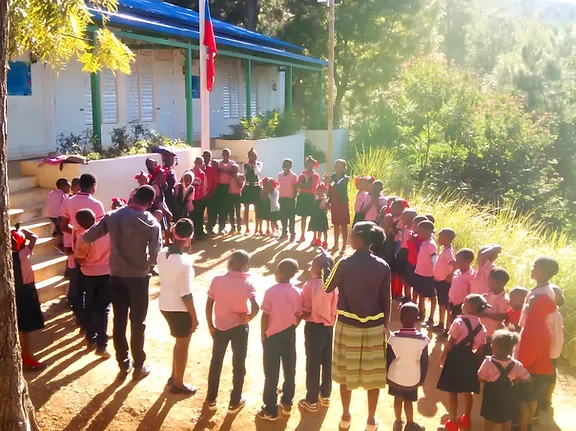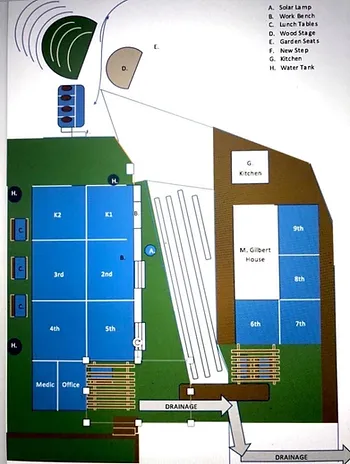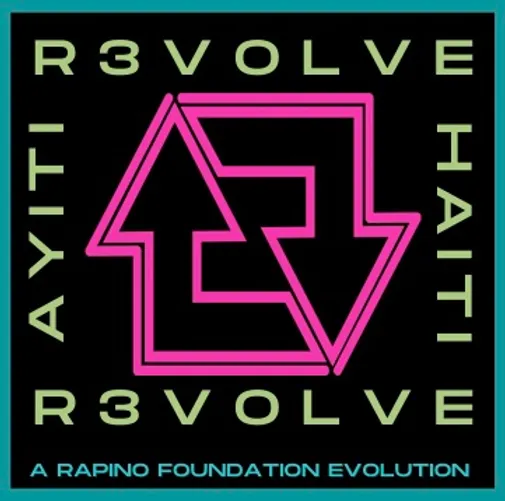In an era where nutrition and sustainability intersect, there lies a unique opportunity to cultivate change from the ground up. The Rapino Foundation, known for its philanthropic endeavours since 2016, is now steering its efforts towards revolutionizing the way children eat at school.
A Sustainable Approach to School Lunches
The Foundation has embarked on a mission to establish a parent/teacher-led school lunch program. Unlike any other, this initiative relies heavily on the success of a school garden, poised to not only provide fresh produce for students but also act as an educational tool.
This isn’t just about filling lunch boxes; it’s about nourishing minds with the knowledge of where food comes from, the importance of sustainable agriculture, and the beauty of community involvement.
From Seed to Plate
The plan is ambitious but simple. Over the course of one year, with the help of dedicated teachers, parents, and students, the school garden aims to yield a harvest substantial enough to sustain the lunch program. Should the harvest exceed the school’s requirements, the excess will be sold to offset the costs of the program, ensuring its continued viability.
Why Your Support Matters
As with all initiatives of such magnitude, financial support plays an integral role. The Foundation has set up a GoFundMe fundraiser to cover the start-up costs and sustain the program until it becomes self-reliant through the garden’s produce and potential sales.
For those interested in the intricate details of how this initiative will be implemented, a comprehensive plan is available on the GoFundMe page and the Rapino Foundation’s official website at www.rapinoFoundation.com (http://www.rapinofoundation.com/). This resource serves as a guide for any school or community eager to embark on a similar sustainable journey.
Join the Movement
The Rapino Foundation has always believed in empowering communities. With their track record of providing free education by covering teacher salaries and supporting school needs, this new venture promises to be another feather in their cap.
By supporting this fundraiser, you’re not just investing in a lunch program. You’re investing in a sustainable future, community empowerment, and the invaluable lesson that change truly begins at the grassroots level.
Join us, and let’s plant the seeds of change together.
Haiti’s Blue Diamond Mountain School Sustainable Lunch Program
Prepared by Jolene Rapino 8.21.23
OVERVIEW & PURPOSE
Vision: At the heart of our rural mountain school in Haiti lies a profound belief: every child, regardless of circumstance, deserves the chance to flourish. Our proposed lunch program isn’t just about feeding bodies—it’s about nourishing souls, fueling dreams, and weaving a tapestry of community resilience and hope.
Why This Matters:
- Soulful Nutrition: Our children are the keepers of tomorrow’s dreams. We strive to offer them meals that are more than just sustenance. These are plates filled with love, care, and the promise of a brighter future.
- Education Beyond Books: A child with a full belly possesses the clarity and drive to chase their dreams. By ensuring they are well-fed, we are paving the way for academic brilliance and igniting their inner potential.
- A Symphony of Community: Our program is a dance of unity—a call to every parent, guardian, and community member to come together. When we collaborate, our collective heartbeat echoes a rhythm of sustainable growth and undying hope.
- Empowering Our Roots: Every grain, vegetable, and drop of water sourced for this program is a testament to our faith in the local community. Together, we celebrate our heritage, our farmers, and the fertile land that sustains us.
- Seeds of Wisdom: Beyond meals, we impart lessons of life. Our children learn the sacred bond between earth and plate, understanding the cyclical beauty of nature and the importance of respecting and nurturing our environment.
- A Pledge of Inclusivity: In our school, every child is a beacon of limitless potential. No barriers, especially not economic ones, should dim their light. Our shared commitment ensures every student, every day, feels seen, valued, and loved.
At the core of our lunch program lies a dream—a dream where our children grow strong, our community stands united, and the future holds endless possibilities. Together, hand in hand, heart to heart, we move towards making this dream our lived reality.

Action List for Sustainable Lunch Program
The responsibilities will be split between someone handling Parent Engagement (PE) and someone focusing on the Agriculture side (AG): Both (PE) and (AG) will report to Marie Line who will oversee the project.
Parent Engagement (PE) – Lovely
1. Initial Planning & Research
- Connect with Metre Gilbert on the need for parent participation and for his assistance in facilitating administrative and logistic needs.
- Create a Parent Volunteer profile sheet for each family. List student, list all caregivers, phone numbers, address, etc.
- Meet with parents – Communicate the need for parent involvement. Complete the Parent Volunteer Profile’ form.
- Provide extra Parent profile sheets to Metre Gilbert for parents unable to attend and students who may enroll later in the year.
- Link ‘Cold Lunch Program’ budget here. ( Marie Line)
2. Community Engagement –
- Hold community meetings to discuss the lunch program’s goals and benefits. (Marie Line)
- Invite parents and community members to volunteer (cooking, gardening, contribution, etc.).
- Set up a sliding scale or voluntary contribution system for those who can contribute. (See below, Parent participation – ‘Sliding Scale’)
3. External Funding
- Launch and manage the crowdfunding campaign, emphasizing the importance and impact of the program. (Jolene)
4. Volunteer System (See below, Parent participation – ‘sliding scale’, ‘Parent Volunteer Profile’ form, )
- Complete the ‘Parent Profile Volunteer’ forms, one for each family.
- Create a volunteer schedule, ensuring rotation to spread responsibilities.
- Establish a feedback mechanism for volunteers to share experiences and suggestions.
5. Training & Workshops
- This is a potential future idea where parents with a certain skill set can come and teach the children about gardening or cooking.
6. Communication & Transparency
- Regularly update the community on the program’s progress.
- Celebrate milestones and successes with the community.
- Address any concerns or suggestions in a timely manner.
7. Regular Monitoring & Evaluation (in collaboration with AG)
- Collect feedback from students, parents, and volunteers regarding the meals and program impact.
- Coordinate with the Agriculture person to make necessary adjustments.
Parent Participation
Sliding Scale
A sliding scale for parent volunteer participation allows parents to contribute time and effort based on their availability, capacity, and skills. This approach can promote inclusivity, ensuring that all parents have an opportunity to be involved regardless of their circumstances.
Participation Sliding Scale
1. Level of Engagement
High Engagement:
- Hours per week: 5-10 hours
- Tasks: Leading initiatives, managing teams of other volunteers, overseeing specific projects, conducting workshops based on skill sets.
Medium Engagement:
- Hours per week: 2-5 hours
- Tasks: Assisting team leaders, maintaining school garden, helping with food prep or distribution, participating in meetings.
Low Engagement:
- Hours per week: 1-2 hours
- Tasks: Minor tasks like distributing food, cleanup after meals, attending occasional meetings, assisting in workshops.
Occasional Engagement:
- Hours per month: 1-3 hours
- Tasks: Helping in special events, attending monthly or quarterly meetings, providing specific expertise when needed.
2. Skills & Expertise
- Culinary Skills: Assisting with meal planning, preparation, and training.
- Farming/Gardening: Assisting in the school garden, providing expertise, and leading agricultural initiatives.
- Education & Training: Leading or assisting workshops, providing skill training.
- Organizational & Management: Leading volunteer teams, organizing events, managing resources.
- Arts & Crafts: Engaging students in creative projects, decoration for events, making educational materials.
- Technical & Maintenance: Helping with equipment maintenance, setting up technical tools or systems.
- Communication & Outreach: Promoting events, liaising with the community, managing communication channels.
3. Frequency of Contribution
- Regular (Weekly): For parents who can commit on a routine basis.
- Bi-weekly: For parents who can contribute every other week.
- Monthly: For parents with limited availability but can commit once a month.
- On-call/As-needed: For parents who cannot commit regularly but are available for specific events or tasks.
4. Optional Financial Contribution
For parents who cannot volunteer time but wish to contribute financially:
- High Contribution: Suggested amount (e.g., $6/month = .30 per meal).
- Medium Contribution: Suggested amount (e.g., $3/month = .15 per meal).
- Low Contribution: Suggested amount (e.g., $1/month = .075 per meal).
- One-time Contribution: Any amount, given at the parent’s discretion.
Parents can use this sliding scale to select the level of engagement, identify their skills and expertise, choose the frequency of their contribution, and decide on any financial contributions. It’s essential to emphasize that all contributions, regardless of scale, are invaluable and deeply appreciated. This template can be modified to better fit the specific needs and circumstances of our school community.
Parent Volunteer Management
Managing parent volunteer hours is crucial to ensure fair distribution of tasks, acknowledge contributions, and maintain a consistent flow of help. Here’s a template to help you manage and track the hours:
‘Parent Profile Volunteer’ form
1. Volunteer Information:
- Full Name: ______________________________
- Contact Number: ______________________________
- Email Address: ______________________________
- Child’s 1 Name & Grade: ______________________________
- Child’s 2 Name & Grade: ______________________________
- Child’s 3 Name & Grade: ______________________________
- Child’s 4 Name & Grade: ______________________________
- Additional Caregivers Name: ______________________________
- Contact Number: ______________________________
- Email Address: ______________________________
2. Availability:
- Preferred Days of the Week:
- Monday
- Tuesday
- Wednesday
- Thursday
- Friday
- Saturday
- Sunday
- Preferred Time Slot:
- Morning (e.g., 8 AM – 11 AM)
- Midday (e.g., 11 AM – 2 PM)
- Afternoon (e.g., 2 PM – 5 PM)
3. Skills & Expertise (Tick appropriate boxes):
- Culinary
- Farming/Gardening
- Education & Training
- Organizational & Management
- Arts & Crafts
- Technical & Maintenance
- Communication & Outreach
4. Volunteer Log: (Placed into Excel)
Date: ______________________________
Start Time: ______________________________
End Time:______________________________
Total Hours: ______________________________
Task/Activity: ______________________________
Supervisor/Coordinator Signature: ______________________________
5. Feedback & Comments:
______________________________
______________________________
______________________________
6. Acknowledgment:
- Total Hours for the Month/Quarter: _________
- Coordinator’s Note: _____________________________________________________________
Notes:
- Ensure volunteers sign in and out each time they volunteer to keep the records accurate. (Maitre Gilbert will need to manage this. Lovely will make sure it’s done well)
- Periodically review and acknowledge significant contributions (e.g., monthly or quarterly) with a small event or token of appreciation. (Discuss as a team)
- This template will be digitized using tools like Google Sheets or Excel for easier management and calculation of hours. (Does Lovely know how to use either of these programs?) (Can someone in admin teach her?) These sheets should be shared access to each of us plus any other appropriate person and stored in the Foundation Administration google drive as well as a trello card created with appropriate links.
We can adjust this template according to the specific needs of our school and its community. It will serve as both a record for the school and a tool for parents to understand their contributions.
Agriculture (AG) Anaida
1. Initial Planning & Research
- Make a comprehensive assessment of the current school garden. (See ‘Garden Assessment’ questions)
- Research local seeds and tool prices and any potential farming partnerships outside of the two organizations that we know about.
- Estimate costs related to agriculture and set an initial budget.
2. Local Collaborations – (See Sohaderk and Wynn Farm Collaboration ideas)
- Connect with Pierre Paul of SOHADERK for his wisdom for sourcing seeds, tools, and other necessary equipment either used or at a discount.
- Connect with Wynn Farm
3. School Garden Initiative
- Identify and allocate space for the garden. Make sure the garden is protected from roaming animals.
- Create an official budget for: seeds, tools, and other necessary equipment.
- Organize a community gardening day to kick-start the initiative.
- Link agriculture budget here ( Marie Line)
4. Regular Monitoring & Evaluation (in collaboration with PE)
- Monitor the health and yield of the garden and any other agricultural initiatives.
- Adjust strategies as needed based on feedback and evaluations.
After Garden has been successful for a year
- Introduce Income-Generating Projects
- Explore feasible projects as additional revenue sources for the school (e.g., selling surplus produce or value-added products).
- Menu Creation & Nutrition
- Draft a diverse menu using cost-effective, locally available ingredients.
- Ensure the meals meet necessary nutritional standards.
- Review and update the menu seasonally or as needed.
3. Training & Workshops
- Conduct workshops on sustainable/profitable agriculture and gardening for interested parents and community members.
Evaluating the current state and challenges of the existing garden will help you plan improvements and integrate it effectively into the lunch program. Here’s a comprehensive list of questions:
Garden Assessment Questions
Action List for Sustainable Lunch Program
The responsibilities will be split between someone handling Parent Engagement (PE) and someone focusing on the Agriculture side (AG): Both (PE) and (AG) will report to Marie Line who will oversee the project.
Parent Engagement (PE) – Lovely
1. Initial Planning & Research
- Connect with Metre Gilbert on the need for parent participation and for his assistance in facilitating administrative and logistic needs.
- Create a Parent Volunteer profile sheet for each family. List student, list all caregivers, phone numbers, address, etc.
- Meet with parents – Communicate the need for parent involvement. Complete the Parent Volunteer Profile’ form.
- Provide extra Parent profile sheets to Metre Gilbert for parents unable to attend and students who may enroll later in the year.
- Link ‘Cold Lunch Program’ budget here. ( Marie Line)
2. Community Engagement –
- Hold community meetings to discuss the lunch program’s goals and benefits. (Marie Line)
- Invite parents and community members to volunteer (cooking, gardening, contribution, etc.).
- Set up a sliding scale or voluntary contribution system for those who can contribute. (See below, Parent participation – ‘Sliding Scale’)
3. External Funding
- Launch and manage the crowdfunding campaign, emphasizing the importance and impact of the program. (Jolene)
4. Volunteer System (See below, Parent participation – ‘sliding scale’, ‘Parent Volunteer Profile’ form, )
- Complete the ‘Parent Profile Volunteer’ forms, one for each family.
- Create a volunteer schedule, ensuring rotation to spread responsibilities.
- Establish a feedback mechanism for volunteers to share experiences and suggestions.
5. Training & Workshops
- This is a potential future idea where parents with a certain skill set can come and teach the children about gardening or cooking.
6. Communication & Transparency
- Regularly update the community on the program’s progress.
- Celebrate milestones and successes with the community.
- Address any concerns or suggestions in a timely manner.
7. Regular Monitoring & Evaluation (in collaboration with AG)
- Collect feedback from students, parents, and volunteers regarding the meals and program impact.
- Coordinate with the Agriculture person to make necessary adjustments.
Parent Participation
Sliding Scale
A sliding scale for parent volunteer participation allows parents to contribute time and effort based on their availability, capacity, and skills. This approach can promote inclusivity, ensuring that all parents have an opportunity to be involved regardless of their circumstances.
Participation Sliding Scale
1. Level of Engagement
High Engagement:
- Hours per week: 5-10 hours
- Tasks: Leading initiatives, managing teams of other volunteers, overseeing specific projects, conducting workshops based on skill sets.
Medium Engagement:
- Hours per week: 2-5 hours
- Tasks: Assisting team leaders, maintaining school garden, helping with food prep or distribution, participating in meetings.
Low Engagement:
- Hours per week: 1-2 hours
- Tasks: Minor tasks like distributing food, cleanup after meals, attending occasional meetings, assisting in workshops.
Occasional Engagement:
- Hours per month: 1-3 hours
- Tasks: Helping in special events, attending monthly or quarterly meetings, providing specific expertise when needed.
2. Skills & Expertise
- Culinary Skills: Assisting with meal planning, preparation, and training.
- Farming/Gardening: Assisting in the school garden, providing expertise, and leading agricultural initiatives.
- Education & Training: Leading or assisting workshops, providing skill training.
- Organizational & Management: Leading volunteer teams, organizing events, managing resources.
- Arts & Crafts: Engaging students in creative projects, decoration for events, making educational materials.
- Technical & Maintenance: Helping with equipment maintenance, setting up technical tools or systems.
- Communication & Outreach: Promoting events, liaising with the community, managing communication channels.
3. Frequency of Contribution
- Regular (Weekly): For parents who can commit on a routine basis.
- Bi-weekly: For parents who can contribute every other week.
- Monthly: For parents with limited availability but can commit once a month.
- On-call/As-needed: For parents who cannot commit regularly but are available for specific events or tasks.
4. Optional Financial Contribution
For parents who cannot volunteer time but wish to contribute financially:
- High Contribution: Suggested amount (e.g., $6/month = .30 per meal).
- Medium Contribution: Suggested amount (e.g., $3/month = .15 per meal).
- Low Contribution: Suggested amount (e.g., $1/month = .075 per meal).
- One-time Contribution: Any amount, given at the parent’s discretion.
Parents can use this sliding scale to select the level of engagement, identify their skills and expertise, choose the frequency of their contribution, and decide on any financial contributions. It’s essential to emphasize that all contributions, regardless of scale, are invaluable and deeply appreciated. This template can be modified to better fit the specific needs and circumstances of our school community.
Parent Volunteer Management
Managing parent volunteer hours is crucial to ensure fair distribution of tasks, acknowledge contributions, and maintain a consistent flow of help. Here’s a template to help you manage and track the hours:
‘Parent Profile Volunteer’ form
1. Volunteer Information:
- Full Name: ______________________________
- Contact Number: ______________________________
- Email Address: ______________________________
- Child’s 1 Name & Grade: ______________________________
- Child’s 2 Name & Grade: ______________________________
- Child’s 3 Name & Grade: ______________________________
- Child’s 4 Name & Grade: ______________________________
- Additional Caregivers Name: ______________________________
- Contact Number: ______________________________
- Email Address: ______________________________
2. Availability:
- Preferred Days of the Week:
- Monday
- Tuesday
- Wednesday
- Thursday
- Friday
- Saturday
- Sunday
- Preferred Time Slot:
- Morning (e.g., 8 AM – 11 AM)
- Midday (e.g., 11 AM – 2 PM)
- Afternoon (e.g., 2 PM – 5 PM)
3. Skills & Expertise (Tick appropriate boxes):
- Culinary
- Farming/Gardening
- Education & Training
- Organizational & Management
- Arts & Crafts
- Technical & Maintenance
- Communication & Outreach
4. Volunteer Log: (Placed into Excel)
Date: ______________________________
Start Time: ______________________________
End Time:______________________________
Total Hours: ______________________________
Task/Activity: ______________________________
Supervisor/Coordinator Signature: ______________________________
5. Feedback & Comments:
______________________________
______________________________
______________________________
6. Acknowledgment:
- Total Hours for the Month/Quarter: _________
- Coordinator’s Note: _____________________________________________________________
Notes:
- Ensure volunteers sign in and out each time they volunteer to keep the records accurate. (Maitre Gilbert will need to manage this. Lovely will make sure it’s done well)
- Periodically review and acknowledge significant contributions (e.g., monthly or quarterly) with a small event or token of appreciation. (Discuss as a team)
- This template will be digitized using tools like Google Sheets or Excel for easier management and calculation of hours. (Does Lovely know how to use either of these programs?) (Can someone in admin teach her?) These sheets should be shared access to each of us plus any other appropriate person and stored in the Foundation Administration google drive as well as a trello card created with appropriate links.
We can adjust this template according to the specific needs of our school and its community. It will serve as both a record for the school and a tool for parents to understand their contributions.
Agriculture (AG) Anaida
1. Initial Planning & Research
- Make a comprehensive assessment of the current school garden. (See ‘Garden Assessment’ questions)
- Research local seeds and tool prices and any potential farming partnerships outside of the two organizations that we know about.
- Estimate costs related to agriculture and set an initial budget.
2. Local Collaborations – (See Sohaderk and Wynn Farm Collaboration ideas)
- Connect with Pierre Paul of SOHADERK for his wisdom for sourcing seeds, tools, and other necessary equipment either used or at a discount.
- Connect with Wynn Farm
3. School Garden Initiative
- Identify and allocate space for the garden. Make sure the garden is protected from roaming animals.
- Create an official budget for: seeds, tools, and other necessary equipment.
- Organize a community gardening day to kick-start the initiative.
- Link agriculture budget here ( Marie Line)
4. Regular Monitoring & Evaluation (in collaboration with PE)
- Monitor the health and yield of the garden and any other agricultural initiatives.
- Adjust strategies as needed based on feedback and evaluations.
After Garden has been successful for a year
- Introduce Income-Generating Projects
- Explore feasible projects as additional revenue sources for the school (e.g., selling surplus produce or value-added products).
- Menu Creation & Nutrition
- Draft a diverse menu using cost-effective, locally available ingredients.
- Ensure the meals meet necessary nutritional standards.
- Review and update the menu seasonally or as needed.
3. Training & Workshops
- Conduct workshops on sustainable/profitable agriculture and gardening for interested parents and community members.
Evaluating the current state and challenges of the existing garden will help you plan improvements and integrate it effectively into the lunch program. Here’s a comprehensive list of questions:
Garden Assessment Questions

1. Basic Garden Overview:
- What is the total size/area of the garden?
- What are the current crops/plants being cultivated?
- How long has this garden been in place?
- Are there dedicated gardeners or caretakers? If so, how many?
2. Care & Maintenance:
- How often is the garden watered, and what is the source of water?
- Are there any irrigation systems in place?
- What type of soil is predominant in the garden? Has the soil been tested for quality and nutrients recently?
- What fertilizers or soil amendments are currently being used?
- How often are weeding and other routine maintenance tasks performed?
3. Pest & Disease Management:
- Have there been any recent issues with pests or diseases?
- What methods (organic or chemical) are used for pest control?
- Are there beneficial insects or natural predators being employed or present in the garden?
- How often are pest and disease checks conducted?
4. Harvest & Yield:
- How often is the garden harvested?
- What has been the average yield of key crops over the last season?
- Are there crops that consistently underperform or fail?
5. Infrastructure & Tools:
- What tools and equipment are currently available for gardening tasks?
- Is there a composting system in place? If so, how is it managed?
- Are there any storage facilities for harvested produce?
- Are there any shaded or greenhouse areas for seedlings or sensitive plants?
6. Challenges & Limitations:
- What have been the primary challenges in maintaining or expanding the garden?
- Are there specific resources or skills that are lacking?
- Is there difficulty accessing certain materials or inputs like seeds, organic fertilizers, or tools?
- How has the weather or climate impacted the garden? Are there issues with drought, excessive rain, or other environmental factors?
7. Community Engagement & Education:
- Are students or parents currently involved in garden activities? If so, in what capacity?
- Is the garden used as an educational tool? Are there lessons or activities conducted in or about the garden?
- What feedback have you received from those involved about the garden?
8. Vision & Goals:
- What is the current primary purpose of the garden? (e.g., educational tool, food production, community space)
- Are there any plans or visions for the garden’s future that haven’t been implemented yet?
This list will provide a comprehensive overview of the garden’s current state and help identify areas that may need improvement or further investment as you integrate it into the lunch program.
SOHADERK and Wynn Farm
Collaboration Ideas (Anaida, go over these ideas with each organization line by line make a note of which ideas each organization is most excited about)
Collaborating with local ecological organizations can provide a wealth of benefits, from knowledge exchange to shared resources. Here are some ideas for possible collaborations between our school’s lunch program and such organizations:
- Educational Workshops: Invite experts from these organizations to conduct workshops for students, parents, and teachers on topics like local biodiversity, sustainable farming, and ecological conservation.
- Resource Sharing: Partner with ecological organizations to share resources such as seeds of local varieties, composting methods, and organic farming tools.
- Garden Design & Biodiversity: Ecological organizations may have experts who can help design the school garden in a way that promotes local biodiversity, improves soil health, and conserves water.
- Composting & Waste Management: Collaborate to set up composting systems for organic waste from the school kitchen. This not only reduces waste but also provides rich compost for the garden.
- Eco-Friendly Infrastructure: Partner to design and implement eco-friendly infrastructure, such as rainwater harvesting systems, solar-powered kitchen equipment, or sustainable pest control methods.
- Field Trips: Organize field trips to local ecological reserves, organic farms, or conservation projects managed by these organizations, providing practical learning experiences for students.
- Conservation Initiatives: Engage students in local conservation efforts led by these organizations, such as tree planting drives, community clean-up events, or wildlife protection programs.
- Local Ecological Produce: Collaborate to source organic and sustainably grown seeds and produce from local farmers associated with these organizations. This can help promote local biodiversity by supporting crops that are native and adapted to the local ecosystem.
- Research & Documentation: Partner with organizations to document local plant and animal species, traditional farming practices, and indigenous knowledge. This can be integrated into the school curriculum and can even be published as educational materials.
- Joint Events & Campaigns: Co-organize events, fairs, or campaigns focusing on sustainability, local ecology, and nutrition. Such events can raise awareness, involve the broader community, and even generate funds. We have already completed an incredibly successful summer camp with SOHADERK. Next summer, let’s make sure the parents and children of the Nan Panyol school are included.
- Promotion & Advocacy: Use the platforms of these organizations to promote the sustainable initiatives of the school lunch program and advocate for similar programs in other institutions.
- Shared Volunteer Network: Ecological organizations often have a network of volunteers passionate about sustainability. This network can be tapped into for assistance with not only the school’s initiatives but also for all organizations.
- Ecological Certification: Some organizations offer certifications or recognition for sustainable and eco-friendly practices. The school can aim to achieve such certifications, boosting its reputation and encouraging other institutions to follow suit. This gives the parents as volunteers, the children as students and the school, an honor to work towards. If these certificates of honor do not exist, we will create them with SOHADERK and Wynn Farm by creating the criteria needed to earn the honor of the certificate.
When approaching such collaborations, it’s essential to focus on mutual benefits and shared goals. We want the school and the ecological organizations that we are working in partnership and contributing to a larger cause and also that we value their insights and guidance with gratitude.
Keys for Success:
By splitting the responsibilities between two people in this manner, each person can focus on their domain of expertise, ensuring a more effective and sustainable program. Please be as specific and detailed with information as possible. Collaboration and open communication between Anaida and Lovely will be crucial for the program’s success as well as their ability to communicate their findings to Marie Line in a timely manner.




